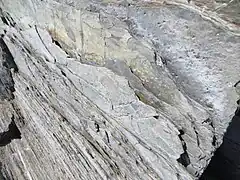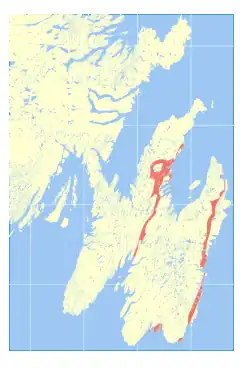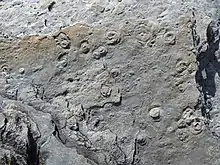Fermeuse Formation
The Fermeuse Formation is a fossil-bearing Ediacaran geologic formation in Newfoundland.
| Fermeuse Formation | |
|---|---|
Stratigraphic range: | |
 Beds of the Fermeuse Formation near Ferryland, NL; note Aspidella discs | |
| Type | Formation |
| Unit of | St John's Group[1] |
| Underlies | Renews Head Formation[2] |
| Overlies | Trepassey Formation |
| Location | |
| Region | Newfoundland and Labrador |
| Country | Canada |
 Occurrence of Fermeuse formation in southeast Newfoundland | |
Palaeobiological community

On Avalon Peninsula[1] there is low diversity, and includes rare trace fossils, Palaeopascichnus,[3] and Aspidella discs, sometimes in great concentrations.[4]
On Bonavista Peninsula there is higher diversity, including more fronds (rangeomorphs) and better preserved than on Avalon Peninsula.[1]
Depositional environment
On Bonavista Peninsula the depositional environment was a slope and outer shelf–below photic zone Turbidites probably were the dominant sediment transporters.[4]
It is predominantly silts and sands, in contrast to underlying Trepassey Formation, which is mostly dark grey shales. There is a coarsening up sequence throughout the two formations, such that the top of the Fermeuse is predominantly sandstones.[4]
On Avalon Peninsula there were much shallower waters, particularly than in underlying Mistaken Point Formation and Trepassey Formation.[1] It is indicated by sandy channel fills, slumping, occasional silts.[1] There is a possible delta front and shallow slope setting.[1]
References
- A.G. Liu; D. McIlroy. "Horizontal Surface Traces from the Fermeuse Formation, Ferryland (Newfoundland, Canada), and their Place within the Late Ediacaran Ichnological Revolution".
{{cite journal}}: Cite journal requires|journal=(help) - "Geoscience Atlas". Department of Natural Resources, Government of Newfoundland and Labrador.
- Mikhail A. Fedonkin (2007). The Rise of Animals: Evolution and Diversification of the Kingdom Animalia. JHU Press. p. 54. ISBN 978-0-8018-8679-9.
- LAFLAMME, MARC; SCHIFFBAUER, JAMES D.; NARBONNE, GUY M.; BRIGGS, DEREK E. G. (June 2011). "Microbial biofilms and the preservation of the Ediacara biota". Lethaia. 44 (2): 203–213. doi:10.1111/j.1502-3931.2010.00235.x.
- Various Contributors to the Paleobiology Database. "Fossilworks: Gateway to the Paleobiology Database". Retrieved 17 December 2021.